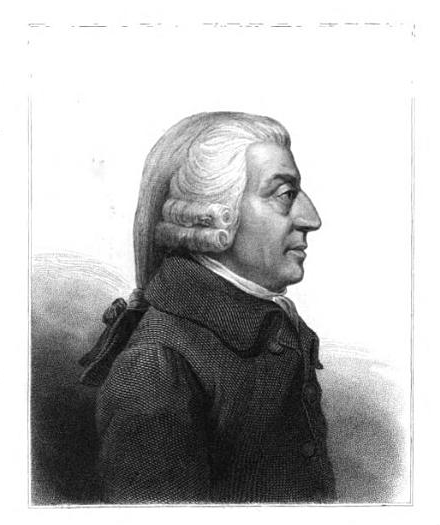The Ongoing Search for Adam Smith (with Freakonomics)
January 26, 2023

The Freakonomics podcast wants to present Adam Smith as a person - not just two old books on a shelf. Did they succeed? Find out what Skwire says.

The Freakonomics podcast wants to present Adam Smith as a person - not just two old books on a shelf. Did they succeed? Find out what Skwire says.
Who was the real Adam Smith? Was Adam Smith really a right-winger? Can Adam Smith fix our economy?
The Freakonomics podcast recently produced a three-part series on Adam Smith featuring a lot of names (Russ Roberts! Glory Liu! Dennis Rasmussen!) that will be familiar to readers of AdamSmithWorks that attempts to answer the above questions.
The Freakonomics podcast recently produced a three-part series on Adam Smith featuring a lot of names (Russ Roberts! Glory Liu! Dennis Rasmussen!) that will be familiar to readers of AdamSmithWorks that attempts to answer the above questions.
I’m not sure the Freakonomics crew answers any of these questions effectively, but they do delineate some of the perennial debates about Smith, and perhaps, help to demonstrate how these debates distract from the most valuable parts of Smith.
The first episode, “In Search of the Real Adam Smith” begins by laying out the classic presentation of Smith as the author of two books with fundamentally different premises. “That first book — the one no one reads — it is essentially a call for what many modern liberals say they most believe in: sympathy. The second book, the famous one, is a call for what many modern conservatives say they most believe in: a free-market economy with less government involvement.” They note that both sides reduce Smith to a caricature.
In an attempt to transform these caricatures of Smith back into a portrait of an actual human, Freakonomics travels to Scotland. Much of the episode is taken up with visits to important places in Smith’s life--Kirkcaldy, the Kirk, the Firth of Forth, and so on--used as opportunities to cover parts of Smith’s biography. Given that the podcast format means we’re unable to see any of these places, I found this aspect of the episode much less interesting than the time spent talking about Smith with experts.
I found Glory Liu’s contextualizing of Smith’s Wealth of Nations particularly stark and effective. When we call Smith the father of modern economics, we really mean it. As she notes,
“The state of the field was not like, “I’m writing a new economics textbook for millions of college students in the United States to get their college degree.” The state of the field was, ‘Are we going to beggar other nations and send more gunboats out so that we can hoard more gold and coin? Or should we actually care about whether we have regulations that prevent people from working in jobs that would actually give them a meaningful way of life?’”
Craig Smith’s discussion of Theory of Moral Sentiments is, perhaps, the most useful part of the episode for those who are already reasonably familiar with Smith. He makes a good case for Theory of Moral Sentiments as a description of human moral behavior that is not only accurate but also groundbreaking.
It’s predominantly about explaining to you what happens when you make a moral decision. And the way in which he does that, I think, is really, really quite striking. He’s able to point to things that readers today recognize in their own lives as reactions that they have to scenarios. And he’s able to build that and make an account, a coherent account of all of the different things that come together to make our moral lives. I think that’s a very radical thing to do in moral philosophy.
Given that the goal of the episode was to present a fuller portrait of Smith, I’m glad that Dennis Rasmussen was there to humanize our understanding of Smith with his discussion of the friendship between Smith and David Hume. Despite my enormous fondness for Smith, however, discussions of that friendship nearly always leave me feeling more charmed by and drawn to Hume and his warmth and humor than to Smith. I wanted Freakonomics to let me hear more from Rasmussen--about Smith’s and Hume’s wrangling with Jean-Jacques Rousseau, perhaps, or about Hume’s teasing letters to Smith about his book sales. If the goal of the episode was to present Smith as a person rather than as two books on a shelf, more of this detail would have helped.
At the end of the episode, I think Freakonomics hasn’t given us that fully human portrait of Smith. While we’ve gone beyond caricature, I’m not sure we’ve gotten much farther than the marble statue of Adam Smith that stands in the entryway of the Adam Smith Business School in Glasgow…that the podcast tells us about, but cannot let us see.
Keep your eyes ready from upcoming reviews of part 2 and part 3 from the series.
Want more?
Sabine El-Chidiac's Take A Trip, Come Away With Us—to Scotland! (with pictures!)
Glory Liu's Inventing the Invisible Hand
Craig Smith's A Hotbed of Genius: An Introduction to the Scottish Enlightenment
Dennis C. Rasmussen's The Infidel and the Professor: The Friendship of Adam Smith and David Hume